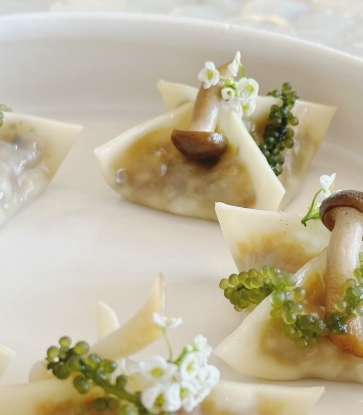Abu Dhabi is known for being a melting pot for a variety of nationalities, and with that comes multicultural food experiences celebrating diverse flavours across the emirate. Of course, the MICHELIN Guide Abu Dhabi 2023’s selection mirrors this global city’s diversity and shines a light on a wide range of culinary cultures.
From Thai and Italian to Lebanese and many more, Abu Dhabi’s MICHELIN-selected restaurant chefs champion their hometown flavours through their exciting menus. Their dishes pay homage to their respective gastronomic traditions and tell the story of their heritage and background.
We spoke to three MICHELIN chefs who shared their favourite comfort foods from home and how they’ve managed to reinterpret in their kitchen.
Silk & Spice
MICHELIN-Selected, MICHELIN Guide Abu Dhabi 2023
Dish: Tom Yum Kong
A hearty soup that is a traditional favourite amongst Thai homes and many Thai restaurants. Tom yum combines a hot broth with staple Thai ingredients such as shrimp, chili paste, fresh kaffir lime leaves, lime juice, lemongrass and fish sauce. The hot and sour flavours are rich and pack a punch with every bite, but for chef Navaphon Peansing from MICHELIN-selected restaurant, Silk & Spice, his memories of Tom Yum have a slight twist.
Growing up in Buri Ram, a province in North-Eastern Thailand, the Peansing family did not have access to fresh seafood, due to the landlocked surroundings and would have to travel far to get it, which was not always easy. When cooking for the family, his mother would make their region’s adaptation of this popular Thai dish.
“My mother made the soup with a clearer broth and used chicken instead of seafood, we would eat it almost every day,” he says. “She also used young tamarind instead of lime to create the sour taste.”
He brings the same Tom Yum recipe his mother used to make for him to his own kitchen. “I brought the flavours from my home and use the same techniques I grew up with.” Through this, the chef tells story of his hometown and allows his diners to explore a different version of typically seafood dish. “It’s a way for me to share the warm memories I have from when my mother used to cook for me.”
Dish: Yum Nua Yang
Another one of Peansing’s ultimate comfort foods is yum nua yang, or better known as spicy Thai beef salad. Similar to the Tom Yum soup, this dish was also part of his mother’s daily menu throughout his childhood. “I grew up with this dish every day and whenever I visit her during my holiday, she makes this for me,” he said.
Traditionally, yum nua yang is served with marinated raw beef in Thailand, however, for Peansing, he serves it with a slight sear. “I do this because I want everyone to enjoy the dish, as not many people are used to eating raw beef,” he added.
While the beef dish was reinterpreted in his kitchen, the simple yet powerful flavours maintain the essence of his childhood dish. He honours his mother’s recipe by including the fresh and spicy ingredients diners want from Thai cuisine such as spicy Thai chilies, sliced beef, red onions, lime, coriander and fish sauce.
“I want my guests to leave my restaurant with that same family feeling I get whenever I eat these dishes,” he said. “I want to share the same joy and happiness I get from eating with my family.”
Café Milano
MICHELIN-Selected, MICHELIN Guide Abu Dhabi 2023
With octopus being the star of the dish, Polpo Valentino is an ode to chef Delfino Chiarello’s home in the Eastern part of Sicily. “This dish represents exactly the place I come from,” said the Café Milano chef. While he serves it with more finesse and added elements, Chiarello’s inspiration comes from a much simpler dish that holds great memories.
“During the day, in my childhood, my father, my brother and I would either go straight to the market to pick out fresh octopus, or we would head out to the water and go catch some,” he recalls. “It was always something we should have at home, we would roast it in the oven, marinated with our own version of Salmoriglio sauce, and have it with some homemade bread.”
In the restaurant located in Abu Dhabi’s Four Seasons Hotel, Chiarello elevates the heart of his humble and comforting dish to a more refined level at Café Milano. Guests can enjoy his version of his hometown favourite with the eatery’s Polpo Valentino with similarly roasted octopus, fregola pasta with roasted tomato puree, basil, candied tomato, fennel and celery salad.
“It creates an emotional connection,” he explained. “As a chef, it’s important for my diners to taste where I come from originally, because the food we make represents who we are.”
Dish: Branzino Ceviche
The Sicilian chef’s culinary background is naturally influenced by seafood, fish, and citrus fruits, such as the famous Sicilian blood orange and lemons. His comfort foods during childhood comprised of simple dishes that highlighted the flavours of all these ingredients.
While ceviche is essentially a Peruvian staple, made of raw fish and fresh citric elements, it comes as no surprise that Chiarello considers this a comfort food. “Even though I am from Sicily, the kitchen is really my home,” he explains. “It’s where I learn a lot every day and grow as a chef. And of course, I love fish, and I love cooking fish,” the Sicilian chef continues. “There is always something attached to me with the flavour, the seasoning and the lightness of the aroma coming from a citrus base.”
The branzino ceviche he makes at Café Milano honours the Peruvian dish and Italian ingredients he grew up around. His love for fresh fish shines as he serves it raw and cubed pairing it with a lime ginger chili dressing, sweet potato purée, avocado, red radish, red onions, herbs salad and pickled yellow mustard seeds.
His emotional ties to both are married in a dish that draws inspiration from the ingredients that remind him of his Sicilian roots and the dishes he learned to love working in the kitchens throughout his career.
Beirut Sur Mer
MICHELIN Bib Gourmand, MICHELIN Guide Abu Dhabi 2023
The iconic dip is made from a blend of chickpeas, tahini, lemon juice and garlic – and is a must have on every Lebanese table. “It’s such a special dish!” says chef Georges Zgheib from Bib Gourmand restaurant, Beirut Sur Mer. “You can have it for breakfast, lunch and dinner – and you can eat it every day.”
Coming from the Northern part of Lebanon, from the Becharre district’s Haddath el Jebbeh, the chef’s love for hummus is shared by many Lebanese people, as well as the region, now gaining popularity as a globally renowned and versatile dish. It’s a staple in every Lebanese household but can be served in various forms.
“Traditionally we would mix it with meats, with cauliflower, with falafel and even use it for the base to make fatteh (a Lebanese savoury layered dish made with garlic infused yogurt mixed with chickpeas and tahini),” he says. “All of our meals always included hummus.”
Thanks to the dish’s versatility, Zgheib puts his own spin on the Lebanese staple in the restaurant. “Our specialty is hummus topped with fresh crab meat, apricot chutney sauce and the green zaatar, which creates a lovely combination,” he says, describing his interpretation of a classic dish.
Dish: Raw Meat
“No Lebanese meal is complete without it,” Zgheib exclaims. Raw meat is a popular Lebanese mezze that can be enjoyed in a variety of ways.
Whether it’s kibbeh nayyeh, teble nayyeh, habra nayyeh, these appetizers are prepared by selecting specific parts of lamb, grounding it and with a choice to mix it with bulgur or mixed spices. They are usually eaten in small bites scooped up with torn pieces of Lebanese Pita bread and combined with garlic sauce, mint, raw white onion and olive oil.
“I love it so much because of its rich history connected to area I’m from in Lebanon,” chef Georges explains. “During the war, people were scared to make any fires when cooking their meats so they would eat it raw, and we’ve been eating it ever since.”
In Beirut Sur Mer, Zgheib serves his favourite Lebanese specialty as authentic as possible. “I didn’t want to change anything to the dish because it’s such an iconic dish among Lebanese and the best way to eat it is in the traditional way,” he explains.



















